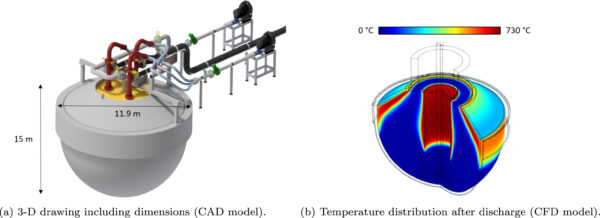Researchers from the Technical University of Denmark have proposed to use Carnot batteries to convert coal power plants to renewable energy production.
Carnot batteries are systems that store electricity in the form of heat through storage media, such as water or molten salt, and transform the heat back to electricity when needed. This category includes liquid air energy storage (LAES) systems and Brayton or Rankine based pumped thermal energy storages (PTES) systems, as well as Lamm-Honigmann storage, which is a sorption-based technique that can be charged and discharged with both heat and electrical power, and systems based on integrated resistive heating with power cycles.
The scientists explained that decommissioned coal power plants are ideal sites to combine electric heaters and thermal storage as they enable the reuse of existing equipment, such as steam turbines, heat recovery boilers and heat exchangers. “Furthermore, conventional generators, rather than inverter-based resources, are able to retain a significant amount of inertia for grid frequency stabilization,” they said.
The group investigated, in particular, coal power plant retrofits using packed bed thermal energy storage and applied their approach to a Chilean 300 MW coal power facility with a production of live steam at 565 C and 160 bar.
For their modeling, the scientists considered a packed bed facility with a storage capacity of 1.37 GWh and a storage temperature of 730 C. The system utilizes atmospheric air as the heat transfer fluid (HTF) and solid material as the storage medium. The heaters, valves, and inlet and outlet pipes are placed on top of the system to avoid additional excavation and allow the rock bed to be installed partially below ground level, making maintenance easier.

Image: Technical University of Denmark, Journal of Energy Storage, Creative Commons License CC BY 4.0
“The estimated thermal losses for this configuration are 1.94% per day, while the maximum pressure loss over the packed bed, in this work observable during discharge, is calculated to be 49 mbar,” the team said. “The charging time was selected to use the maximum hours of sunlight to represent the use of renewable power from photovoltaic (PV) plants, and in this way, the discharge will take place during the night or when the sunlight is not available.”
In the proposed system configuration, the PV plants power the storage system's electric heater connected to the storage tank, which in turn provides heat to the steam generator connected to the coal power plant's steam turbine and condenser.

Through their analysis, the scientists found that the retrofitted plant may achieve an annual net power production of around 443 GWh for 4 h storage capacity, 797 GWh for 8 h storage capacity, and 1,150 GWh for 12 h storage. “These values are around 3.4% lower when the air temperature at the steam generator inlet is set to 590 C,” they explained.
They also found that the system's highest annual round-trip efficiency was achieved for a storage capacity of 8 h, and that the lowest levelized cost of energy (LCOE) is reached for the largest storage capacity at €88.09 ($95.97)/MWh. “This value appears competitive with both state-of-the-art conventional power plants and alternatives such as the ones powered with thermal storages based on molten salt,” they added.
Their findings were introduced in the paper “Retrofit of a coal-fired power plant with a rock bed thermal energy storage,” published in the Journal of Energy Storage.
The team noted that a follow-up study implementing the tools developed in the work in a techno-economic optimization could pave the way towards implementation, identifying the ideal operation and sizing for lowest cost and maximum revenue.
Another research team at the Technical University of Denmark this year investigated what levelized cost of storage (LCOS) Carnot batteries require in order to become competitive in a 100% renewables scenario for their home country. They found that an LCOS of less than €66.2/MWh would be competitive, provided that gas prices stay at low levels.
This content is protected by copyright and may not be reused. If you want to cooperate with us and would like to reuse some of our content, please contact: editors@pv-magazine.com.




1 comment
By submitting this form you agree to pv magazine using your data for the purposes of publishing your comment.
Your personal data will only be disclosed or otherwise transmitted to third parties for the purposes of spam filtering or if this is necessary for technical maintenance of the website. Any other transfer to third parties will not take place unless this is justified on the basis of applicable data protection regulations or if pv magazine is legally obliged to do so.
You may revoke this consent at any time with effect for the future, in which case your personal data will be deleted immediately. Otherwise, your data will be deleted if pv magazine has processed your request or the purpose of data storage is fulfilled.
Further information on data privacy can be found in our Data Protection Policy.